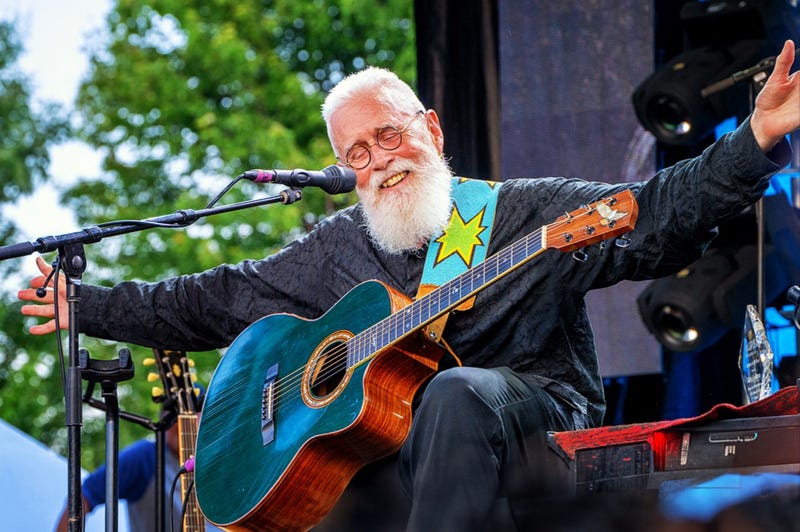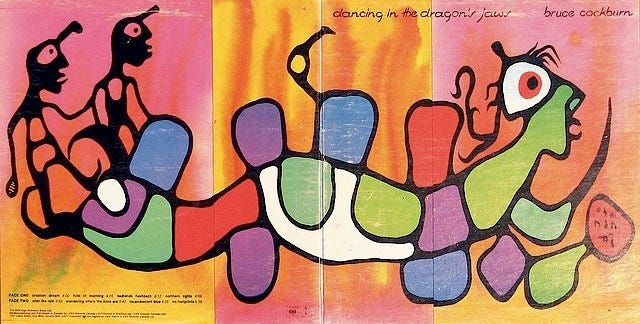Shining like gold, but better
Rumours of Bruce Cockburn. Plus: Me on Morgan Wallen, and a superb Sade tribute

Today is the day we wish Bruce Cockburn a happy 80th birthday.
Cockburn is relegated to the second tier of the Canadian pantheon, on a lower deck of the Tower of Song than the penthouses where your Jonis and Leonards, Neils and Gordons reside. Not saying that’s inappropriate, but he deserves more celebration while we’re still fortunate to have him.
Different people have different Bruce Cockburns. There are the guitar aficionados who marvel at his fingerpicking on both acoustic and electric. There are the lefties rallied by his salvos on conflicts in Central America and elsewhere as well as environmental issues, especially in the eighties and nineties—a few of them not quite getting that the upshot of “If I Had a Rocket Launcher” is ultimately that he’s relieved he doesn’t.
There are those who might know only “Lovers in a Dangerous Time” in the Barenaked Ladies cover, and/or quote the lyric, “You’ve got to kick at the darkness till it bleeds daylight” on social media. I’m always struck by the kinship between that line and another of the most famous ones in Canadian music, Leonard Cohen’s “There’s a crack in everything, that’s how the light gets in.” Feel free to make this the subject of your next Canadian Studies essay.
Written in 1984, “Lovers” shapeshifted over time to feel like a song about the AIDS crisis, and while we’re not inclined to give the BNLs a lot of credit around this newsletter, I do imagine they had that in mind when they recorded it in 1991. Last year, Cape Breton-born country singer Drake Jensen’s video for his cover put it more explicitly in an LGBTQ+ context.
Then there are those who follow Cockburn because he found his way out of the post-sixties crackup in the 1970s by embracing Christianity (of the mostly nondenominational variety), and touches on his faith frequently in song.
I was reminded of this a couple of years ago at the wedding of some Ontario friends, when the bride’s dad got up for the father-daughter dance (quiet ‘yuck’) and the soundtrack turned out to be to Cockburn’s 1974 tune, “All the Diamonds in the World.” I was startled as her family didn’t seem like counterculture types—until I remembered that they were, in the sense that they’re devout Baptists. So the key lines to them were the ones about how Jesus’s ship would soon sail in, “like a crystal swan in a sky of suns.” Thankfully, Cockburn’s Christianity is of the mystic and seeking sort, never the intolerant kind. (I’m not sure I can say as much for my friend’s folks.)
The mystic Cockburn sometimes can be one of my favourite Cockburns—in my first year in Montreal, “Creation Dream” was on my set list when I made a stab at busking in the Metro for spare change. Though I thought of it in terms of the Norval Morrisseau painting on the album cover more than of the Book of Genesis.
But generally I like Cockburn best at his most slippery, urbane, tender, and witty moments, still prodigiously imagistic but counterbalancing his tendencies to beret-clad over-earnestness in both his poetics and his jeremiads. Fortunately, I was just getting deeply into music for the first time when Cockburn was at his peak in those modes, around Dragon’s Jaws (1979) and Humans (1980), his most new-wave-influenced record, and the excellent 1981 single “Coldest Night of the Year.” Probably no coincidence that this was also the time of Cockburn’s divorce from his first wife, a condition that can breed a particular state of alertness.
Dragon’s Jaws of course includes Cockburn’s biggest U.S. hit, “Wondering Where the Lions Are,” which got him to #21 on the Billboard chart and to Saturday Night Live. (Sadly I can find no video record.) It’s a song of wry gratitude for the improbability of survival amid Cold War threats—“Sun's up, mm-hmm, looks okay/ The world survives into another day”—while awaiting the inevitable-seeming comeuppance in the grip of “some kind of ecstasy.”
But Humans is my favourite, a record that is worldly but not yet jaded, benefiting by the travel that “Lions” facilitated. It features “Tokyo,” a taut single that anticipates the coming decade’s Japanophilia at least less problematically than the Vapors’ “Turning Japanese” the same year. Then there’s the near-perfect “Rumours of Glory,” which like “Lions” is carried by a very 1980s Toronto reggae lilt, while limning “the extremes of what humans can be”: “In that distance some tension's born/ Energy surging like a storm/ You plunge your hand in, and draw it back scorched/ Beneath, it's shining like gold, but better/ Rumours of glory.” … There’s our old friend, the crack in the darkness, once more letting the light in.
A lesser-known favourite of mine from Humans is “How I Spent My Fall Vacation,” a tour travelogue set in several different countries. It shows off Cockburn’s capacity for writing on multiple discursive levels in tight sequence, and to bend structure to his will and whim. My adolescent mind was blown by this compact drama, three verses deep:
In a Roman street on a full-moon night,
I was sick and there was a young cop in a circle of yellow light.
As we drew near he snapped the safety off his machine pistol and
Slid a trembling finger to the trigger —
I tried to say something calming but couldn't catch his eye
He didn't want contact. He was trained to see movement
”Hey, don't shoot me, man, I'm a graceful, slow dancer,
I'm just a dream to you, not real at all… ”
Lalalala lalala, lala lala, lala lala …
Plus it has the extraordinary Hugh Marsh on violin.
(Sorry about the overlays imposed by the video owners.)
Cockburn lives in San Francisco now, which feels a little sad to me, though California’s probably a good place for an 80-year-old to be (and still with fairly young offspring—you go, Bruce). His voice creaks now but his fingers still fly and he still tours some, including this summer at the Winnipeg Folk Festival among other places. There’s also a sold-out tribute show this weekend in Toronto at Hugh’s Room, featuring Ron Sexsmith, Tom Wilson, Elizabeth Shepherd and more. Catch what you can where you can—because the hours grow shorter as the days go by.
What becomes of the ‘Broken Hearted Sade’?
Coming in a bit late to direct your attention to one of the standout tracks of May: Toronto sax/synth smoothie Joseph Shabason and R&B great Dawn Richard (also in the news, sadly, for her testimony at the Sean Combs trial) combining forces on “Broken-Hearted Sade.” As Shabason explained on Instagram, this was a mashup born spontaneously while he was touring with Richard and Spencer Zahn (who put out a beautiful album together last year): “I would soundcheck with ‘Broken-Hearted Kota.’ Almost immediately after the first soundcheck, Dawn would come in and start singing Sade songs over the chords. It worked so seamlessly that we made it part of the show every night. After the tour ended, we knew we had to record it.”
Besides being a boon to your ears, this song’s proceeds are all going to benefit Humanity Auxilium, who Shabason says “fund doctors who risk their lives daily to provide critical care in Gaza's hospitals.”1 A place of many, many more broken hearts.
How do you solve a ‘problem’ like Morgan Wallen?
I made an attempt to crack the puzzle of the biggest male artist in American music today in Slate last weekend, though as you’ll see it’s more like I cracked under the burden of his two-hour, 37-track new album I’m the Problem. (The ending is more of an exhausted exit than a lasting assessment.) I did have fun with the format though, constructing it as an imaginary text chat with Wallen himself.
I might have gotten a bit further on the subject in conversation with Elamin Abdelmoud, Sarah Boesveld, and Andrea Williams last week on CBC’s Commotion. And my very best crack at it is probably the version on the Slate Culture Gabfest available tomorrow (Wed. May 28) wherever you get your podcasts.
(I also heard from a lot of people who thought understanding the Wallen phenomenon wasn’t worth any further effort. I’ll address that as part of a bigger post on the “poptimism” backlash sometime in “Crritic!” Maybe soon, we’ll see.)
Note that I have not checked on the organization’s funding efforts, so proceed at your own discretion.


I also consider the records you noted as prime Cockburn. I went to see him in concert at John Carroll University in the early 80's shortly after these records had been released. He played with a full electric band and the music was great. However he didn't project much stage dynamism, only to jump (no hops) at the conclusion of the final song. I immediately lost interest in him and never purchased another record. But thanks to your article I will go back and listen again. I imagine they're still great.
Hi Carl, despite your well documented disdain for my life's work, I actually do enjoy most of your commentary on all things arts and music. I just want to correct you on why BNL chose to cover Lovers In A Dangerous Time back in '91. It wasn't the AIDS crisis that motivated us, rather it was the Cockburn song that resonated the most with the band at the time. It was all over the radio when we were music-devouring teens, and it's a great song in all respects. I was the only Cockburn-head in the band at the time, and yes, you and I share the same opinion that DITDJ and Humans are Bruce at his best, but my suggestions of covering either Tokyo or Coldest Night of the Year ("guys he name-drops Scarborough!") were set aside in favor of the Cockburn song that everybody in the band knew. I'm still delighted that it was our first hit, and that we filmed a widely seen clip, in the age of million dollar video budgets, for $11,000 CDN. Bruce Cockburn continues to be an inspiration to Barenaked Ladies, 35 years, 18 studio albums and millions of concert tickets, records and streams later. You don't give BNL any love or credit Carl, but lots and lots and lots of other people do. Ha Ha Ha. Ha Ha Ha Ha Ha. Happy 80th, Bruce!